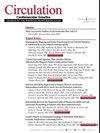Founder Mutations in Myosin-Binding Protein C: Maybe Not So Benign After All.
引用次数: 1
Abstract
Linkage studies and genetic sequencing in families with hypertrophic cardiomyopathy (HCM) in the 1980s and 1990s established the sarcomere as the genetic basis for HCM.1 In contemporary cohorts, a pathogenic mutation is found in about half of patients with HCM, with ≈50% of these mutations in MYBPC3 (myosin-binding protein C).2,3 Many mutations are unique or seen in a limited number of families. However, in some geographically or culturally isolated populations, founder mutations have arisen from common ancestors many generations ago. The reported frequency of founder mutations for HCM ranges considerably among different countries, with the highest reported prevalence being in Iceland, where almost 90% of all sarcomere gene mutation carriers harbor a single founder mutation in MYBPC3 , comprising 67% of the entire HCM population.4 The vast majority of founder mutations in HCM across all reported studies are found in MYBPC3 , with fewer reported in MYH7 (myosin), TNNT2 (troponin T), and TPM1 (tropomyosin).5 Because of the need for founder mutations to withstand negative selection pressure to perpetuate through multiple generations, there is a general perception that founder mutations confer a more benign phenotype and disease course.4,6,7 This view has been supported by a previous study in France, which found that carriers of a founder mutation identified in 8% of their HCM population were diagnosed 15 years later and experienced a delayed onset of disease complications compared with carriers of other sarcomere gene mutations.8 However, other studies have observed relative equivalence between carriers of founder and nonfounder mutations.5,9 All of the previously reported studies are limited by relatively small numbers and some by incomplete genotyping in comparator HCM cohorts, which could confound results. Most studies have also not distinguished between probands and relatives of probands …肌球蛋白结合蛋白C的创始人突变:可能不是那么良性。
本文章由计算机程序翻译,如有差异,请以英文原文为准。
求助全文
约1分钟内获得全文
求助全文
来源期刊

Circulation: Cardiovascular Genetics
CARDIAC & CARDIOVASCULAR SYSTEMS-GENETICS & HEREDITY
自引率
0.00%
发文量
0
审稿时长
6-12 weeks
期刊介绍:
Circulation: Genomic and Precision Medicine considers all types of original research articles, including studies conducted in human subjects, laboratory animals, in vitro, and in silico. Articles may include investigations of: clinical genetics as applied to the diagnosis and management of monogenic or oligogenic cardiovascular disorders; the molecular basis of complex cardiovascular disorders, including genome-wide association studies, exome and genome sequencing-based association studies, coding variant association studies, genetic linkage studies, epigenomics, transcriptomics, proteomics, metabolomics, and metagenomics; integration of electronic health record data or patient-generated data with any of the aforementioned approaches, including phenome-wide association studies, or with environmental or lifestyle factors; pharmacogenomics; regulation of gene expression; gene therapy and therapeutic genomic editing; systems biology approaches to the diagnosis and management of cardiovascular disorders; novel methods to perform any of the aforementioned studies; and novel applications of precision medicine. Above all, we seek studies with relevance to human cardiovascular biology and disease.
 求助内容:
求助内容: 应助结果提醒方式:
应助结果提醒方式:


